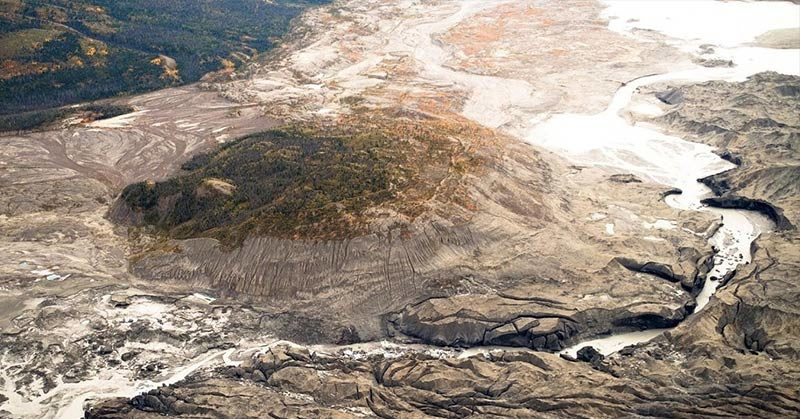Piracy is the practice of robbing another ship at sea. It can also be used to describe stealing in other contexts like hijacking, or “air piracy”. River piracy, however, is a very new concept. Until four years ago, no one had ever documented it in modern times.
In May 2016, the Slims River in Canada’s Yukon completely disappeared in a matter of just four days. Scientists are calling this river piracy, and it is likely another phenomenon of climate change.
River Piracy: The Disappearance of the Slims River
“River piracy” is when the flow of one river suddenly gets diverted to another [1].
The Slims River used to be one of the largest rivers in Canada’s Yukon Territories. It used to be 150 meters at its widest points, and up to ten feet deep. Today, it is a mere trickle of water. This is the first case of river piracy that scientists have documented.
For hundreds of years, meltwater from the Kaskawulsh glacier flowed in the Kluane river. This then ran into the Yukon river toward the Bering Sea. In the spring of 2016, however, the glacier went through a period of intense melting. This tipped the drainage gradient, which redirected the meltwater to the Gulf of Alaska.
A team of scientists had been monitoring the retreat of the glacier for a number of years. In 2016, however, they were shocked at what they found when they returned to the glacier.
“We went to the area intending to continue our measurements in the Slims river, but found the riverbed more or less dry,” said James Best, a geologist at the University of Illinois. “The delta top that we’d been sailing over in a small boat was now a dust storm. In terms of landscape change it was incredibly dramatic.” [2]
It Happened Quickly
They used a helicopter and drones to see what was happening in the other valley and found that the opposite was occurring. While the Slims had all but dried up, the Alsek river was now sixty to seventy times larger than the Slims.
Even more shocking, the change had happened over the course of only a few days- from May 26 to the 29th. While there is evidence of this happening in the distant past, this is the first time scientists have documented such a rapid rerouting of modern river systems [3].
Read: Scientist Create Ultra-White Paint So Reflective It Can Cool Buildings Even In Bright Sunlight
Climate Change and River Piracy
The researchers are almost certain that these drastic changes were a result of climate change. As our planet continues to warm up, they warned that this could start happening more frequently.
According to the team’s statistical analysis, the chances that this could have occurred due to natural variability is 0.5 percent. This means that there is a 99.5 percent chance that climate change is the culprit [4].
This has had a damaging effect on the communities that live near the river, particularly the indigenous peoples who depend on it for survival. The fish, of course, are no longer able to swim there, so an important food source has disappeared.
Additionally, the silt and dust from the river floor is no longer beneath the water. This has caused dangerous dust storms on the nearby Alaska highway. They can be so bad that cars have to pull over until the dust settles.
The Indigenous peoples in this area have been adapting to climate change for years, but some fear that soon they will not be able to keep up.
“Southern Tutchone People and Indigenous Peoples in this area are super resilient and have been adapting to the environmental changes and external factors in this area for a long time. The thing is, is the changes are happening so quickly now that it is hard for us to keep up,” says Amber Berard-Althouse, a Public Outreach Education Officer with Parks Canada at Kluane National Park and Reserve [5].
Read: Ice Melt in Alaska Threatens to Unleash Unprecedented ‘Mega-Tsunami’, Scientists Warn
Fear for the Future
The population in the Yukon is extremely sparse. Future river piracy in more populated areas, however, could have a devastating effect on millions of people.
“If a river changes course so drastically that the drainage basin no longer reaches its original outlet, this change might eventually impact human and biological communities that have grown around the river’s original outlet,” said Rachel Headley, a geologist at the University of Wisconsin-Parkside [1].
Experts are concerned that as climate change continues, river piracy could affect areas in the Himalayas, the Third Pole Region, the Andes, as well as other parts of Canada and Alaska. This could affect the water supplies of millions of people, giving them very little time to adapt.
In order to prevent further river piracy events, we must take action against climate change. That includes individuals, corporations, and governments. The future health of our communities depends on it.
Keep Reading: Solar Is Officially The ‘Cheapest Electricity In History’
- https://www.theguardian.com/science/2017/apr/17/receding-glacier-causes-immense-canadian-river-to-vanish-in-four-days-climate-change
- https://www.theguardian.com/science/2017/apr/17/receding-glacier-causes-immense-canadian-river-to-vanish-in-four-days-climate-change
- https://www.nature.com/articles/d41586-017-00567-0
- https://www.nature.com/articles/ngeo2932
- https://ca.news.yahoo.com/river-piracy-dust-storms-occurring-204200222.html?guccounter=1

